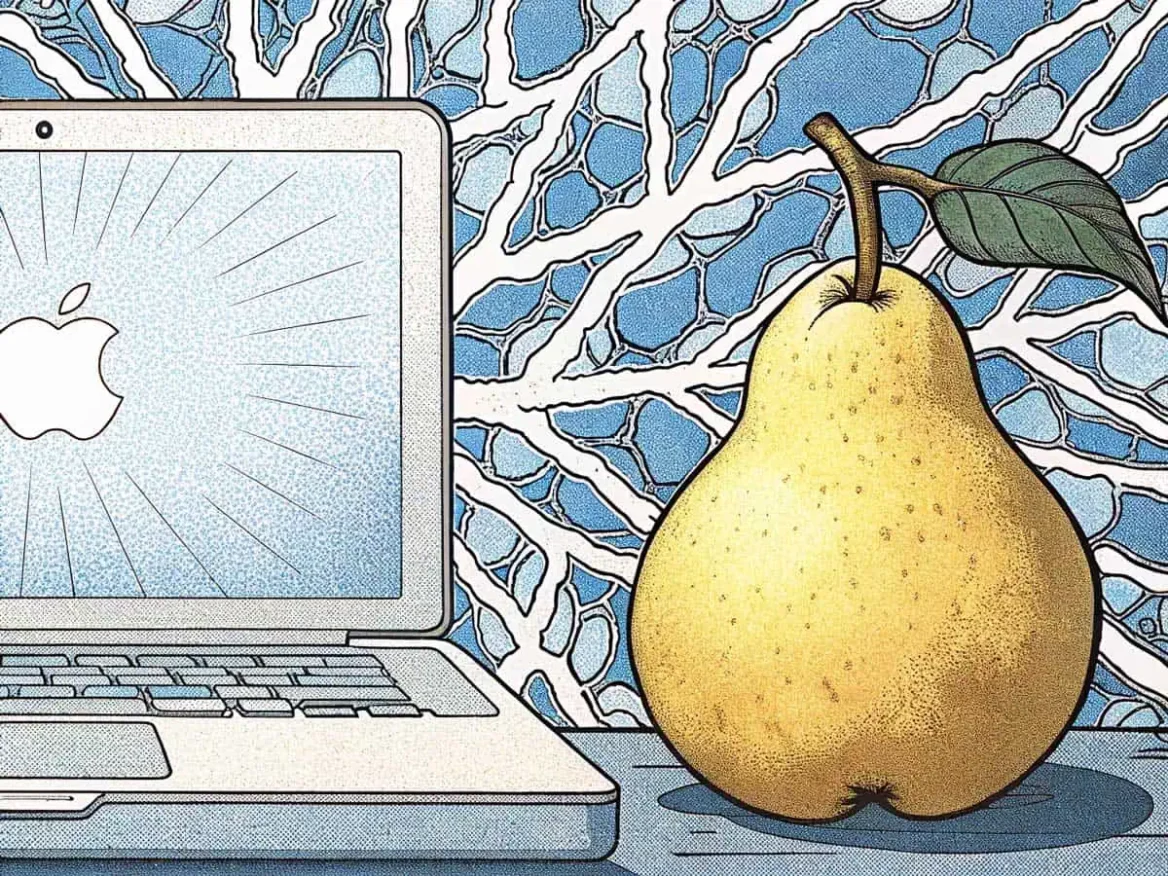I discuss a landmark trademark case in which Apple opposed the registration of a pear as a figurative mark. This article highlights how Apple protects its well-known mark and how judges deal with arguments.
Apple Inc’s legal battle against the registration of a pear as a figurative mark illustrates the limits of trademark protection and, in addition, how well-known marks protect their reputation against dilution and confusion, including in the context of other ‘fruity’ symbols.
Among other things, trademark law is concerned with protecting two functions of a trademark, namely protection of:
- the essential function of the mark: the origin function, which protects the identity of origin (consumers must be able to trust that goods and services bearing a particular mark come from the same company);
- the advertising and goodwill function on the basis of which the proprietor of a (well-known) trade mark can prohibit the use of a similar trade mark for non (similar) goods where such use, without due cause, is likely to take unfair advantage of, or be detrimental to, the distinctive character or repute of the trade mark.
This is also known as the risk of brand dilution.
Mostly the well-known brands
Although non-famous trademarks can also act against a danger of dilution of their trademark, it is mostly the well-known trademarks that use this possibility to counteract the (possible) erosion of the distinctive character of their well-known trademark. One trademark owner that often invokes this danger of dilution of the distinctive character of its well-known mark is Apple Inc.
Apple versus other fruit
Apple often argues (correctly) that its “Apple” is world-famous and for that reason should be protected against third-party registrations of (other) fruit for goods or services that may or may not be (kind of) similar to the goods and services for which Apple has registered its famous trademarks.
A quick check of the database of trademark rulings reveals numerous decisions in which Apple has taken action (successfully or unsuccessfully) against the registration of bananas, pineapples, peaches or even an acorn, which – according to Apple – infringes its Apple trademarks.
Given the results of the aforementioned oppositions, the use of a banana seems, for the time being, the safest. With the other fruits, it is trickier and it was ruled that these marks could not be registered.
The pear has also had Apple’s attention in the past. For instance, in Spain, Italy and the Czech Republic, among others, Apple has usually successfully taken action against these registrations of a pear as a figurative mark.
That is; its opposition was upheld in whole or in part and the mark could not be registered or could be registered only for part of the goods and services for which it was applied for.
Apple versus Pear Technologies
In one specific “apple versus pear case”, parties, litigated in several European courts. The case concerned the registration of the said figurative mark as a Union mark in the name of China’s Pear Technologies Limited.
According to Apple, Pear Technologies’ Pear image is confusingly similar to Apple’s apple or Pear Technologies’ use of this sign takes unfair advantage of or detracts from the distinctiveness or reputation of Apple’s well-known trademarks.
Apple prevailed at first instance before The Opposition Division and later, on appeal, before The Board of Appeal of the EUIPO. These bodies ruled that Pear Technologies’ figurative mark could not be registered as a trade mark, in view of, among other things:
- the high profile of Apple brands;
- the kinship between the characters (apple and pear);
- the fact that using a piece of fruit is highly distinctive and unusual in the technology sector;
- the nature or similarity of the goods and services covered by the signs and the idea that the pear “imitates and at the same time mocks and defies” the apple.
Pear Technologies has appealed this decision to the General Court of the European Union. The court considers – contrary to what the EUIPO Board of Appeal had assumed – that there is no (low degree of) similarity visually and conceptually between the sign of an apple and a pear.
Indeed, the court said, these marks consist of the depiction of two different fruits, an apple and a pear, which can be easily and clearly distinguished by the relevant public visually. The court further considered that visually, the marks make different overall impressions.
On the conceptual comparison of the marks, the court considers that the signs will be understood as an apple from which a bite has been taken and with a leaf, and a pear with a stem. The term ‘fruit’ is only indirectly evoked and it is inconceivable that the public will use the (generic) term ‘fruit’ instead of ‘pear’ or ‘apple’ when referring to the signs.
The CJEU subsequently ruled on 1 October 2019 that the court’s decision was correct, and dismissed Apple’s appeal in this regard.
Saliently, four days before the CJEU decision, Pear Technologies withdrew the registration of its trademark even though it had already won the case in court.
This suggests that Apple already felt the pinch and settled the case with Pear Technologies for a hefty sum – but this is, of course, speculation.
Apple versus Prepear
While it is true that Apple’s oppositions to registrations of figurative marks containing a pear (or other type of fruit) are not always an unqualified success, Apple still seems to be sticking to its tactic of nevertheless always taking action against registrations of signs with fruit (in them) as a trademark, including thus a pear. In November 2019, for instance, Apple filed an opposition to the US registration of a figurative mark by Super Healthy Kids, Inc. on the basis of its earlier figurative mark.
Super Healthy Kids is using its logo for its app Prepear; a platform where food bloggers can upload their recipes and app users can plan their meals and create shopping lists. Although there are, well, five people working at Super Healthy Kids who feel hugely overwhelmed and pressurised by the set opposition of the multinational company Apple, they have picked up the hatchet and indicated that they will defend themselves against Apple’s opposition.
The (US) media dived on this battle of David versus Goliath with enthusiasm. Of course, this issue is also interesting and unctuous for trademark lawyers: will Apple win this opposition?
Since this case is judged by US trademark law, not much can be said about it from a European trademark perspective.
While the grounds on which Apple relies, namely that the pear figurative mark is likely to cause confusion among the public and may or will lead to dilution, are similar to the grounds included in European legislation in Articles 9(2)(b) and (c) of the Union Trade Mark Regulation and Article 2.20(2)(b) and (c) of the Benelux Convention on Intellectual Property, it is therefore impossible to say whether these grounds will be assessed in the same way.
Nevertheless, if we had to make a prediction, by way of a finger exercise, we would fall back on the court’s case against Pear Technologies discussed above. If we rely on the conclusions drawn by the court in this case and assume that the US court assesses the dispute in a similar manner, there is a chance that Apple will also come up short in America.
The Prepear app is registered for the following services:
“an application for organising and planning meals, for evaluating the nutritional content of meals, for creating a searchable database of recipes, and for managing the purchase of recipe ingredients” and the service “On-line social networking in the field of cooking, food and nutrition”.
Given this, it could well be assumed that these services (and thus the figurative mark) are “too far removed” from the goods and services for which Apple has registered and used its Apple trademarks, namely:
“a full line of computer software for business, home, education, and developer use; computer programs for personal information management; database management software; electronic mail and messaging software; database synchronisation software; computer programs for accessing, browsing and searching online databases; operating system software”, “computer services, namely, displaying the images of others on a computer server;” “Personal and social services rendered by others to meet the needs of individuals, namely, online social networking and introduction services; online social networking services”.
Given also the court’s considerations that an apple and a pear can be easily and clearly distinguished by the relevant public visually such that there is neither a likelihood of confusion nor a dilution of the Apple trademarks with Pear Technologies’ pear, then Apple might be out of luck or, if you like, Super Healthy Kids luck. That such an outcome is not merely imaginary also follows – as far as we are concerned – from the (literal) comparison between the figurative marks themselves.
Since Apple lost out in the comparison of (1) to their figurative mark (3), at least in the European Union, the same could easily happen in the comparison of (2) to the figurative mark (3).
In conclusion
The owners of Super Healthy Kids, a married couple, have since started a petition to draw attention to the case and raise money. This is because they feel they have a “moral obligation” to defend themselves against Apple’s claims. So they write on Instagram:
“The CRAZY thing is that Apple has done this to dozens of other small business fruit logo companies, and many have chosen to abandon their logo, or close doors. While the rest of the world is going out of their way to help small businesses during this pandemic, Apple has chosen to go after our small business.”
While such a statement has no legal value, we understand where it comes from.
Incidentally, Apple can easily counter that while the world is indeed upside down at the moment, this does not mean that Apple should accept that other parties infringe on or profit from its famous Apple brands. Brands in which Apple has invested decades of time, money and energy to make them the world-famous brands they are today. Time will tell who ultimately comes out on top.
This article was published on 28 August 2020 in JutD 2020-014. The version on this website contains some minor edits and new headings.


